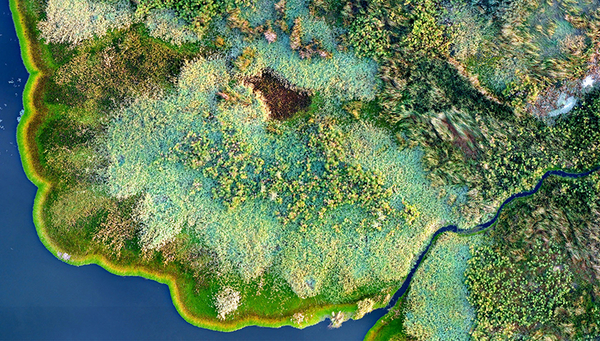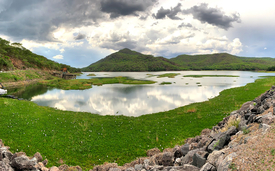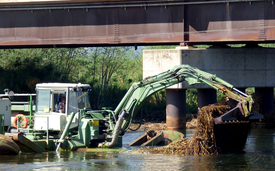News Detail
Natural sewage treatment plants float on the Zambezi River
November 26, 2020 |
They are a beautiful sight to behold: carpets of floating plants such as the water hyacinth (Eichhornia crassipes) in the Zambezi catchment. However, they are also an indicator of inadequate wastewater management in urban and industrial regions of tropical developing countries. After all, where many nutrients accumulate in water, floating aquatic plants find their preferred habitat.
The abundant growth of the plants has been causing Zambia problems for decades. For instance, the water plants regularly clog the reservoirs of hydroelectric power stations – a major challenge for a country that is heavily dependent on hydroelectric power.
Researchers of the aquatic research institute Eawag and ETH Zurich are now shedding a new light on these plant carpets and their importance for the ecosystems of four tributaries of the Zambezi River. According to the researchers, these plants filter the excess nutrients from the water and bind them into biomass. As a result, despite human pollution, the Zambezi River contains largely oligotrophic, i.e. low-nutrient water.
Water hyacinths accumulate in a reservoir of the Zambian hydropower plant "Kafue Gorge Power Station”.
(Photo: RS Winton)
Greater influence than presumed
“The floating aquatic plants buffer the waters,” explains biogeochemist Scott Winton of Eawag’s Surface Waters Division in Kastanienbaum. The researchers had anticipated this result – as water hyacinths are also regularly used in constructed wetlands. In the natural environment, however, there has been little research in this area to date.
Moreover, the researchers around Winton were even able to show that the effect in the river is much greater than expected. “In the heavily polluted tributaries, for example downstream from the town of Livingstone, the phosphorus content in the river would be 20 to 30 percent higher without the floating vegetation,” the researcher says. This also means that without the “floating sewage treatment plants” eutrophication would occur in the water. The ecosystem could therefore change completely, fish could die, and biodiversity could decline massively.
Floating plants are removed at a bridge upstream of the “Kafue Gorge Power Station”.
(Photo: RS Winton)
New strategies are needed
However, the focus has been on the negative aspects of such plant carpets; floating aquatic plants repeatedly clog up Zambia’s waterways and irrigation systems, interfere with shipping and fisheries, and disturb the operation of hydropower plants. For decades, expensive and time-consuming – but not sustainable – campaigns have therefore been conducted with the aim of removing the plants.
The researchers recommend new and holistic strategies for dealing with this issue. They are also in contact with the local operators of the hydropower plants. Winton says: “As long as nutrients from residential and industrial areas continue to enter the surface waters, these plants play an important role in keeping the waters clean. But to prevent them from becoming a problem, we need new approaches for handling them.”
“As long as nutrients from residential and industrial areas continue to enter the surface waters, floating plants play an important role in keeping the waters clean.” Scott Winton
Initial approaches identified
There are already concrete ideas for this. Due to the changing of rainy and dry seasons, the floating plant cover is already subjected to seasonal hydrological cycles. It could be possible to take advantage of this effect, for example with artificial floods. In this case, the dams are opened in a controlled manner to flush the plant material out of the bottlenecks where it typically accumulates and into less problematic areas.
Another idea makes use of the fact that the wind regularly blows the floating plants towards the riverbanks. By keeping the water level artificially high, this can be further supported. If the water level then drops in the dry season, the plants become stranded and can be removed together with the bound nutrients. They then serve local farmers as a low-cost fertiliser or can be used for the production of biofuel.
Not applicable to Switzerland
In Switzerland, the pollution of surface waters with nutrients has decreased considerably since the 1980s because of major efforts in water protection. Nevertheless, there are still some over-fertilised waters. However, there is a lack of natural plant vegetation to act as a buffer. Water hyacinth, which is widespread in the tropics, cannot survive in cool Europe.
Instead, the nutrient surplus promotes the growth of cyanobacteria, algae, and phytoplankton. Unlike the floating plants, however, these plants decay much faster, which leads to a lack of oxygen at the bottom of the lake. As a result, more nutrients are released from the sediments, which further increases over-fertilisation.
Original articles
Collaborations
- ETH Zurich, Institute of Biogeochemistry and Pollutant Dynamics
- ETH Zurich, Chair of Ecosystem Management
- ETH Zurich, Institute of Environmental Engineering
- University of Zambia, Geology Department
Funding
EU Horizon 2020 as part of the DAFNE project
Cover picture: ATEC-3D



